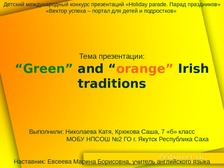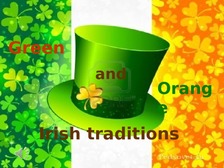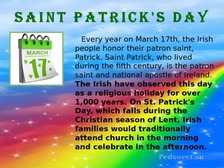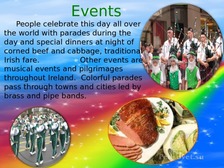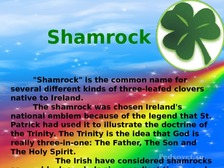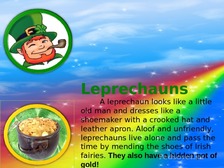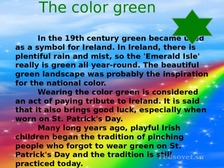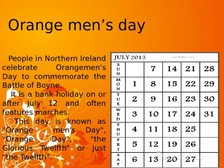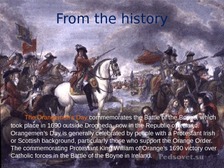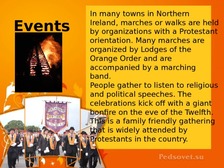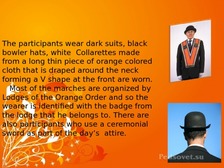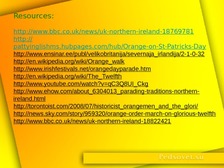Слайд 1: Детский международный конкурс презентаций «Holiday parade. Парад праздников» «Вектор успеха – портал для детей и подростков»
Тема презентации: “Green” and “orange” Irish traditions
Выполнили: Николаева Катя, Крюкова Саша, 7 «б» класс МОБУ НПСОШ №2 г. Якутск Республика Саха
Наставник: Евсеева Марина Борисовна, учитель английского языка
Слайд 2: Green and orange Irish traditions
Слайд 3: Saint Patrick’s day. Every year on March 17th, the Irish people honor their patron saint, Patrick. Saint Patrick, who lived during the fifth century, is the patron saint and national apostle of Ireland. The Irish have observed this day as a religious holiday for over 1,000 years. On St. Patrick's Day, which falls during the Christian season of Lent, Irish families would traditionally attend church in the morning and celebrate in the afternoon.
Слайд 4: Events. People celebrate this day all over the world with parades during the day and special dinners at night of corned beef and cabbage, traditional Irish fare. Other events are musical events and pilgrimages throughout Ireland. Colorful parades pass through towns and cities led by brass and pipe bands.
Слайд 5: "Shamrock" is the common name for several different kinds of three-leafed clovers native to Ireland. The shamrock was chosen Ireland's national emblem because of the legend that St. Patrick had used it to illustrate the doctrine of the Trinity. The Trinity is the idea that God is really three-in-one: The Father, The Son and The Holy Spirit. The Irish have considered shamrocks as good-luck symbols since earliest times, and today people of many other nationalities also believe they bring good luck.
Слайд 6: Leprechauns. A leprechaun looks like a little old man and dresses like a shoemaker with a crooked hat and leather apron. Aloof and unfriendly, leprechauns live alone and pass the time by mending the shoes of Irish fairies. They also have a hidden pot of gold!
Слайд 7: The color green. In the 19th century green became used as a symbol for Ireland. In Ireland, there is plentiful rain and mist, so the 'Emerald Isle' really is green all year-round. The beautiful green landscape was probably the inspiration for the national color. Wearing the color green is considered an act of paying tribute to Ireland. It is said that it also brings good luck, especially when worn on St. Patrick's Day. Many long years ago, playful Irish children began the tradition of pinching people who forgot to wear green on St. Patrick's Day and the tradition is still practiced today.
Слайд 8: "Orange men's Day", People in Northern Ireland celebrate Orangemen's Day to commemorate the Battle of Boyne. It is a bank holiday on or after July 12 and often features marches. This day is known as "Orange men's Day", "Orange Day", "the Glorious Twelfth" or just "the Twelfth".
Слайд 9: The Orangemen’s Day commemorates the Battle of the Boyne, which took place in 1690 outside Drogheda, now in the Republic of Ireland. Orangemen's Day is generally celebrated by people with a Protestant Irish or Scottish background, particularly those who support the Orange Order. The commemorating Protestant King William of Orange's 1690 victory over Catholic forces in the Battle of the Boyne in Ireland.
Слайд 10: Events. In many towns in Northern Ireland, marches or walks are held by organizations with a Protestant orientation. Many marches are organized by Lodges of the Orange Order and are accompanied by a marching band.
People gather to listen to religious and political speeches. The celebrations kick off with a giant bonfire on the eve of the Twelfth. This is a family friendly gathering that is widely attended by Protestants in the country.
Слайд 11: The participants wear dark suits, black bowler hats, white Collarettes made from a long thin piece of orange colored cloth that is draped around the neck forming a V shape at the front are worn.
Most of the marches are organized by Lodges of the Orange Order and so the wearer is identified with the badge from the lodge that he belongs to. There are also participants who use a ceremonial sword as part of the day’s attire.
Слайд 12:
Слайд 13:
Слайд 14: Resources:
http://www.bbc.co.uk/news/uk-northern-ireland-18769781
http://pattyinglishms.hubpages.com/hub/Orange-on-St-Patricks-Day
http://www.ensinar.ee/publ/velikobritanija/severnaja_irlandija/2-1-0-32
http://en.wikipedia.org/wiki/Orange_walk
http://www.irishfestivals.net/orangedayparade.htm
http://en.wikipedia.org/wiki/The_Twelfth
http://www.youtube.com/watch?v=qC3Q8UI_Ckg
http://www.ehow.com/about_6304013_parading-traditions-northern-ireland.html
http://torontoist.com/2008/07/historicist_orangemen_and_the_glori/
http://news.sky.com/story/959320/orange-order-march-on-glorious-twelfth
http://www.bbc.co.uk/news/uk-northern-ireland-18822421
